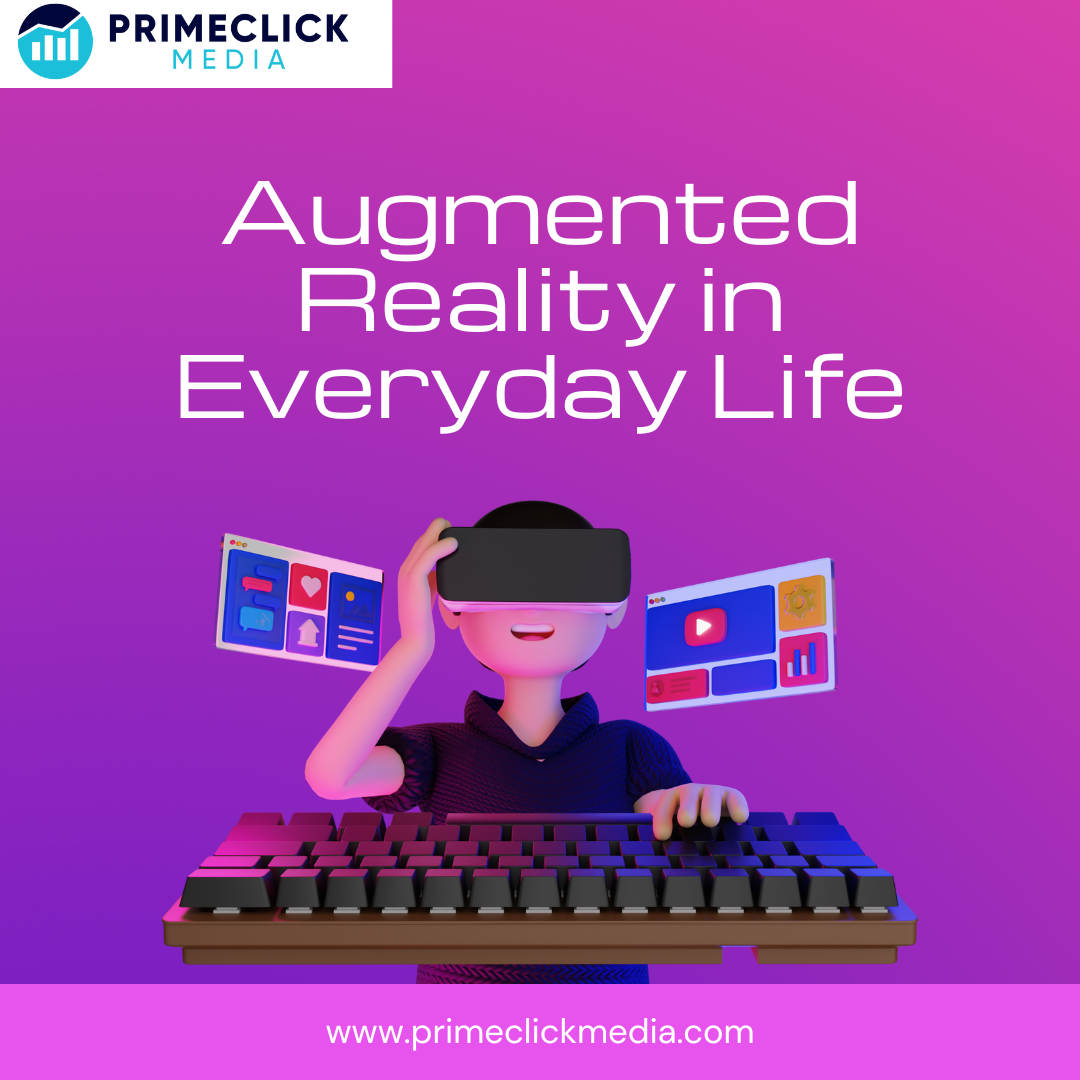Have you ever imagined being able to see digital information superimposed on the real world around you? Well, that’s not just a futuristic dream anymore – it’s a reality with Augmented Reality (AR). Augmented Reality is a technology that blends the digital world with the physical world, adding a layer of interactive and informative elements to our daily experiences.
In this article, we’ll explore how Augmented Reality is becoming an integral part of our everyday lives, making tasks more convenient, entertainment more engaging, and learning more immersive.
What is Augmented Reality?
Augmented Reality (AR) is a technology that blends the real world with digital elements, enhancing our perception of reality by overlaying computer-generated information onto our physical surroundings. In simpler terms, AR adds a layer of interactive and virtual content to what we see and experience in the real world.
Unlike Virtual Reality (VR), which creates an entirely immersive digital environment that users can interact with, AR keeps you rooted in the real world while adding digital elements to it. AR technology uses devices such as smartphones, tablets, smart glasses, and other wearable devices to merge the physical and digital worlds.
AR works by utilizing cameras, sensors, and computer processing to identify and understand the real-world environment. It then superimposes virtual objects, images, text, or animations onto that environment in a way that aligns with what you’re looking at. This creates the illusion that these digital elements are part of the real world, even though they only exist within the digital layer.
Augmented Reality in Everyday Life
Shopping Made Easier
Remember the last time you were shopping and couldn’t decide which furniture piece would fit perfectly in your living room? Augmented Reality apps now allow you to visualize how different items will look in your space before you make a purchase. By simply pointing your smartphone or tablet at an empty spot in your room, you can see a virtual couch, table, or lamp as if it were there. This helps you make better decisions and prevents the hassle of buying something that might not fit or match your décor.
Navigating with Ease
Gone are the days of getting lost in unfamiliar places. Augmented Reality is revolutionizing navigation by providing real-time directions and information overlaid on your view. Walking down the street, you can use AR apps to see arrows guiding you to your destination, restaurant reviews hovering over eateries, and even historical facts about landmarks you pass by. No more squinting at maps – just follow the virtual signs and let AR be your digital guide.
Learning Comes to Life
Studying and learning have taken on a new dimension thanks to Augmented Reality. Imagine reading a history textbook and suddenly being able to witness historical events right in front of you. AR apps can superimpose 3D models of ancient civilizations onto your desk or project chemical reactions happening on your kitchen counter. This hands-on approach makes learning more engaging, helping you grasp complex concepts with ease.
Entertainment Amplified
Augmented Reality isn’t just for serious tasks – it’s also about having fun! Gaming experiences have been transformed by AR, allowing you to interact with virtual characters and objects in your environment. Remember chasing after virtual creatures in popular AR games? These games blend fantasy with reality, making your surroundings part of the gameplay. Whether you’re solving mysteries, building structures, or battling aliens, AR brings a whole new level of excitement to your entertainment.
Healthcare and AR
Even the field of healthcare is embracing Augmented Reality. Surgeons can now use AR during complex procedures, overlaying vital information onto their field of view without taking their eyes off the patient. This improves precision and reduces the risk of errors. Additionally, AR is being used in medical training, enabling students to practice surgeries and procedures in a simulated environment before working on real patients.
Navigation Apps
AR has transformed navigation by providing real-time information overlaid on your view as you navigate through unfamiliar streets. Apps like Google Maps and Apple Maps use AR to display arrows, directions, and points of interest directly on your phone’s camera feed, making it easier to find your way around.
Furniture Shopping
Many furniture retailers offer AR apps that allow you to visualize how different pieces of furniture will look in your home before you buy. You can use your smartphone or tablet to place virtual furniture in your actual living space, helping you make informed decisions about size, style, and placement.
Language Translation
AR apps can translate text in real time, making it easier to understand signs, menus, and other written content in foreign languages. Simply point your device’s camera at the text, and the app will superimpose the translation on your screen.
Social Media Filters
Platforms like Snapchat and Instagram offer AR filters and effects that overlay virtual elements onto your selfies and videos. You can transform your appearance, add fun animations, and even change your surroundings using these filters.
Museum and Art Exhibits
AR is being used in museums and art galleries to provide additional information about exhibits. By pointing your device at a painting or artifact, you can access detailed information, videos, and interactive content that enhance your understanding and appreciation of the artwork.
Educational Tools
AR is revolutionizing education by making learning more interactive and engaging. AR apps can bring textbooks to life, allowing students to explore 3D models, animations, and simulations related to the subject matter.
Real Estate
AR has transformed the way real estate properties are showcased. With AR apps, you can take virtual tours of homes for sale or rent. These apps overlay information about the property and its features onto your view as you explore.
Fitness and Exercise
AR fitness apps can guide you through workouts by superimposing exercise instructions and virtual trainers onto your environment. This helps you maintain proper form and technique while exercising.
Maintenance and Repairs
Some AR apps provide step-by-step instructions for DIY repairs and maintenance tasks. By using your device’s camera, you can receive visual guidance on tasks like assembling furniture, fixing appliances, or repairing a leaky faucet.
Virtual Try-On
In the world of fashion and cosmetics, AR enables virtual try-on experiences. You can see how different clothing items, accessories, or makeup products will look on you before making a purchase.
How Augmented Reality Works?
Augmented Reality (AR) works through a combination of hardware, software, and sensors to blend digital elements with the real world. The process involves identifying the user’s environment, tracking their movements, and then overlaying virtual objects or information onto the real-world view. Here’s a simplified explanation of how Augmented Reality works:
- Hardware Setup: AR requires devices equipped with cameras, sensors, processors, and displays. Common devices include smartphones, tablets, smart glasses, and wearable devices.
- Environment Recognition: The AR system uses the device’s camera to capture the user’s surroundings. Specialized software analyzes the camera feed to understand the physical environment. This involves identifying features like objects, surfaces, and markers that the AR system can use as reference points.
- Tracking and Mapping: Once the environment is recognized, the AR system employs tracking algorithms to continuously monitor the user’s position and movements in the physical environment. This tracking ensures that virtual objects remain properly aligned with the real world as the user moves around.
- Overlaying Digital Content: Based on the tracked information and the user’s viewpoint, the AR system superimposes digital content onto the real-world view displayed on the device’s screen. This content could include images, animations, text, 3D models, videos, or interactive elements.
- Display and Interaction: The user sees the combined view of the real world and the augmented digital content on their device’s screen. They can interact with the virtual objects by touching the screen, gesturing, or using other input methods depending on the device. The AR system responds to these interactions in real-time.
- Integration and Real-Time Updates: AR systems continuously analyze the real-world environment, tracking changes and adjusting the position and appearance of virtual objects accordingly. For instance, if you move closer to a virtual object, the AR system will make it appear larger and more detailed.
- Rendering and Display Updates: The device’s processor renders the combined view of the real and virtual elements in real-time. The AR system ensures that the virtual objects are visually integrated into the scene, taking into account lighting, shadows, and other environmental factors.
- User Experience: From the user’s perspective, the digital content appears seamlessly integrated into their surroundings. This creates the illusion that virtual objects are part of the real world, allowing for interactive and engaging experiences.
Conclusion
Augmented Reality is no longer a concept confined to science fiction; it’s an integral part of our everyday lives. From making shopping decisions easier to turning learning into an immersive adventure, AR enhances our experiences in ways we never thought possible.
As technology continues to evolve, we can expect even more creative applications of AR, further blurring the line between the digital and physical worlds. So, the next time you see a virtual couch in your living room or follow digital arrows on the street, remember that you’re witnessing the magic of Augmented Reality in action.





